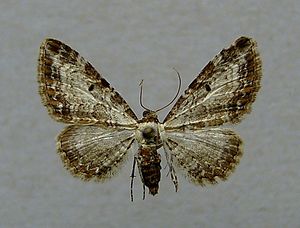Mugwort pods
| Mugwort pods | ||||||||||||
|---|---|---|---|---|---|---|---|---|---|---|---|---|

Mugwort flyworm female |
||||||||||||
| Systematics | ||||||||||||
|
||||||||||||
| Scientific name | ||||||||||||
| Eupithecia succenturiata | ||||||||||||
| ( Linnaeus , 1758) |
The mugwort spanner ( Eupithecia succenturiata ), also known as the tansy spider , is a butterfly ( moth ) from the spanner family (Geometridae).
features
butterfly
The wingspan of the moth is 20 to 27 millimeters. The basic color of the forewings is milky white to chalk white. The front and outer edge are darkened gray-brown to reddish brown. On the Costa , the dark areas are sometimes dissolved into brown spots. A white wavy line runs near the hem area. Some brownish cross lines are in the middle sector, but are mostly indistinct. A large black, slightly oval center, on the other hand, stands out very clearly. The hind wings are white to light gray at the base. The outer area is darker and has a wavy white line through it. A center point is very small or missing entirely. The thorax is hairy white. In the male butterflies, the posterior abdominal segment is also colored white.
egg
The egg has a characteristic shell sculpture, which consists of slightly raised polygonal fields delimited by blurred ridges. It is yellowish to reddish in color.
Caterpillar
Adult caterpillars are purple-gray to brownish and show a blackish diamond pattern on the middle segments and dark side dorsal lines on the middle segments. They also have purple-white side stripes.
Doll
The medium-slender pupae are rust-red to brown in color and show greenish wing sheaths. On cremaster are two strong and each side three thinner hooks bristles.
Similar species
The moths of the wormwood moth can hardly be confused because of their characteristic pattern, but their caterpillars are practically indistinguishable from those of the yarrow moth ( Eupithecia icterata ).
Geographical distribution and occurrence
The mugwort moth is widespread in Europe. The occurrence also extends through Central Asia to China and Kamchatka . In the Pyrenees , the animals can be found up to an altitude of 1800 meters. They prefer steppe areas, open, bushy terrain, fallow and grassland areas as well as park landscapes.
Way of life
The moths are nocturnal and fly in one generation from mid-May to early September. They also appear in both sexes in artificial light sources . The caterpillars live in September and October. They feed mainly on the leaves, flowers and fruits of various plants, such as common mugwort ( Artemisia vulgaris ), tansy ( Tanacetum vulgare ), common yarrow ( Achillea millefolium ) and bogberry ( Vaccinium uliginosum ). The pupae overwinter.
Danger
In Germany the mugwort moth occurs in all federal states and is listed as not endangered on the Red List of Endangered Species .
swell
Individual evidence
- ↑ a b c d e Vladimir Mironov: The Geometrid Moths of the World . In: Axel Hausmann (Ed.): The Geometrid Moths of Europe . 1st edition. Volume 4: Larentiinae II. Perizomini and Eupitheciini . Apollo Books, Stenstrup 2003, ISBN 87-88757-40-4 (English).
- ↑ a b c Walter Forster, Theodor A. Wohlfahrt: The butterflies of Central Europe. Volume 5: Spanner. (Geometridae). Franckh'sche Verlagshandlung, Stuttgart 1981, ISBN 3-440-04951-5 .
- ^ Günter Ebert (Ed.): The butterflies of Baden-Württemberg. Volume 9. Moths VII. Geometridae 2nd part . 1st edition. Ulmer, Stuttgart (Hohenheim) 2003, ISBN 3-8001-3279-6 .
- ↑ Manfred Koch , Wolfgang Heinicke, Bernd Müller: We determine butterflies. Volume 4: Spanner. 2nd, improved and enlarged edition. Neumann, Leipzig / Radebeul 1976, DNB 780451570 .
- ↑ Federal Agency for Nature Conservation (Ed.): Red List of Endangered Animals in Germany . Landwirtschaftsverlag, Münster 1998, ISBN 3-89624-110-9 .
literature
- Vladimir Mironov: The Geometrid Moths of the World . In: Axel Hausmann (Ed.): The Geometrid Moths of Europe . 1st edition. Volume 4: Larentiinae II. Perizomini and Eupitheciini . Apollo Books, Stenstrup 2003, ISBN 87-88757-40-4 (English).
- Günter Ebert (Ed.): The butterflies of Baden-Württemberg. Volume 9. Moths VII. Geometridae 2nd part . 1st edition. Ulmer, Stuttgart (Hohenheim) 2003, ISBN 3-8001-3279-6 .
- Walter Forster , Theodor A. Wohlfahrt : The butterflies of Central Europe. Volume 5: Spanner. (Geometridae). Franckh'sche Verlagshandlung, Stuttgart 1981, ISBN 3-440-04951-5 .
Web links
- Lepiforum e. V. Photos
- www.kolumbus.fi caterpillar
- ukmoths.org.uk UK moths
- www.nic.funet.fi distribution worldwide
- www.schmetterlinge-deutschlands.de Endangerment
- Eupithecia succenturiata at Fauna Europaea. Retrieved June 22, 2012
